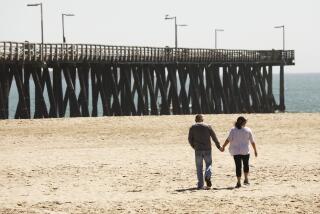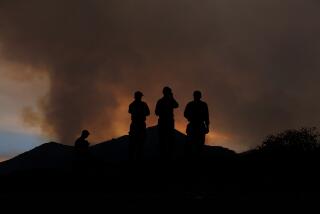Eruptions Force New Evacuation at Clark Air Base
- Share via
SAN MARCELINO, Philippines — Three major new eruptions rocked Mt. Pinatubo late Wednesday night and early today, forcing another emergency evacuation of Clark Air Base and increasing fears of even more violent explosions from the long-dormant volcano in the days ahead.
Mudslides cut roads and blocked one village after fierce thunderstorms and lightning lit afternoon skies, which were eerily darkened from giant volcanic clouds that dropped up to two inches of coarse gray ash and fist-sized pieces of pumice on villages, trees and fields along a 50-mile stretch southwest of the volcano.
An eruption at 8:41 a.m. this morning caused an earthquake so strong it “sent seismograph needles off the chart,” as registered 60 miles south in Manila, said Jessie Daligdig, a government geologist. Villagers tied wet kerchiefs on their faces and used rakes, shovels and pieces of wood to push the blanket of snow-like ash from roads. At times, winds whipped the grit into the air, forcing cars to use windshield wipers and headlights in blizzard-like conditions through the afternoon.
Despite the volcano’s fury, there was little reported damage and only one known fatality from the daylong series of eruptions. A Filipino serving with the U.S. Navy was killed when his car collided with a bus on an ash-slickened road north of the Subic Bay Naval Base.
Many of the villages were holding Independence Day celebrations when heavy gray clouds first began raining ash Wednesday morning. The mayor here in San Marcelino, 17 miles southwest of the volcano, was giving a speech to several thousand people when dark clouds suddenly blotted out the sun and turned day to night.
“We thought it was the end of the world,” said Manuel R. Tan, 31, a shopkeeper here who used a wooden rice rake to shovel ash from the street.
He said townspeople panicked as falling ash and pumice engulfed the town for nearly two hours in near-darkness. “All the women in the market cried,” he said.
Farther north, in San Narciso, Police Chief Wilfredo Navarrete said more than 1,000 schoolchildren were lined up to watch a flag-raising in the tree-shaded town square when the morning skies suddenly turned as dark “as a total eclipse.”
“What they do is pray,” he recalled. “They stand up, closed their eyes and prayed for two or three minutes. The ash was falling all around.”
Calixto Macalma Jr., a police intelligence officer, said people panicked as it began “raining sand.” Church bells pealed in alarm, sirens wailed and many ran for shelter. “It was the first time for us,” Macalma added.
Cris Leomo, disaster coordinator for Zambales province, where most of the ash fell, said villagers were told to place a wet towel on their faces as the gray gloom deepened, and several small villages were evacuated.
Philippine civil defense officials said they had evacuated 19,369 people from villages within a 12-mile radius of the volcano by late Wednesday. Along the roads, some people wore cardboard boxes on their heads for protection, some rode their water buffaloes to safety.
In at least one case, in San Rafael, an evacuation center holding nearly 2,000 people was itself evacuated as large pieces of pumice pummeled the area.
“They cried, they cried,” said Farima Ladringan, a government social worker who was at the center. She said some Negrito people at the center “panicked and ran away” before the rest were trucked away to safer centers.
Another 330 villagers, who had ignored earlier warnings to flee Aglao hamlet, finally abandoned their homes Wednesday afternoon. They were taken by truck to a relief center set up at the Laoag Elementary School in San Marcelino, where officials handed out cooked rice, canned sardines and foil-wrapped chicken frankfurters for dinner.
“There were big stones, like this,” said one woman, holding out her fists. “We are very scared.”
Thousands of residents of Angeles City, east of the volcano, initially fled in panic from the booming morning blasts and greenish-gray mushroom cloud that towered over the area. Passenger jeeps sped through the streets, refusing to stop for riders as the drivers ran for cover. Most residents later returned to the sprawling city.
President Corazon Aquino helicoptered to refugee centers near Angeles briefly before returning to Manila for an Independence Day rally and parade at Luneta Park. She authorized the release of $1.42 million for relief efforts.
U.S. officials, who evacuated 14,635 Americans from Clark to Subic Bay on Monday, withdrew another 600 to a nearby agricultural college after the first eruption at 8:51 a.m. Wednesday.
The 600 returned to the base about four hours later. But they were ordered to evacuate a second time about 11 p.m. after two more blasts, apparently more violent than the three morning eruptions, rocked the area.
Meanwhile, 900 Americans remained to guard the base. But they moved near Dau village on Clark’s eastern perimeter, farthest from the volcano.
Clark, which lies 8.6 miles east of the volcano, could be partially buried by ash and volcanic fragments in a major eruption if winds shift. An Associated Press photographer who flew over the mountain said the Crowe Valley aerial combat range at Clark already is covered with gray ash, and lush green tropical peaks “looked like the Alps in winter.”
The eruptions put Clark’s future in growing jeopardy. Air Force officials are considering repatriating to the United States thousands of Clark’s residents now jammed into cramped quarters at Subic Bay, and now they must consider whether and how to reactivate the giant base if the volcano remains active.
Clark is headquarters of the 13th Air Force, a major transit point for the Military Airlift Command and a key logistic facility for U.S. forces in the Pacific. Washington and Manila have negotiated for a year over the future of Clark and Subic, but talks deadlocked last month.
Raymundo Punongbayan, head of the Philippine Institute of Volcanology and Seismology, said radar indicated that the late-night eruptions sent a plume of smoke and ash more than 15 miles high. Prevailing winds carried the clouds westward into the South China Sea.
He said the day’s eruptions sent pyroclastic flows of super-hot gases, steam and fiery volcanic fragments roaring down the mountain’s western and northern slopes. Most of the deadly debris flowed into the Marella, Maraunot and Moraza riverbeds, and there were no reports of property damage.
The thick ash and pumice covering the area’s lush paddy fields is likely to affect agriculture, however. “The bigger disaster taking place is the economic disaster,” Defense Secretary Fidel V. Ramos told reporters.
Also, Punongbayan said, the heavy afternoon rains triggered mudflows from loose debris on the mountain’s upper slopes that blocked roads and cut off the village of Moraza.
More to Read
Sign up for Essential California
The most important California stories and recommendations in your inbox every morning.
You may occasionally receive promotional content from the Los Angeles Times.














